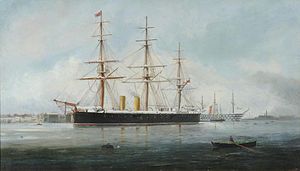| HMS Hercules (1868) | |
|---|---|
 HMS Hercules painted by Henry J. Morgan in 1869. | |
| Career | |
| Name: | HMS Hercules |
| Builder: | Chatham Dockyard |
| Laid down: | 1 February 1866 |
| Launched: | 10 February 1868 |
| Completed: | 21 November 1868 |
| Fate: | Broken up, 1932 |
| General characteristics | |
| Displacement: |
8,677 long tons (8,816 t) 8,830 long tons (8,972 t) full load |
| Length: | 325 ft (99 m) |
| Beam: | 59 ft (18 m) |
| Draught: |
24 ft (7.3 m) light 26 ft 6 in (8.08 m) deep load |
| Propulsion: | One-shaft Penn trunk engine, 7,178 ihp (5,353 kW) |
| Sail plan: | Full rigged ship, sail area 49,400 sq ft (4,590 m2) |
| Speed: |
14.69 knots (16.90 mph; 27.21 km/h) under power 11 knots (20 km/h) under sail |
| Complement: | 638 |
| Armament: |
• 8 × 10-inch (254 mm) rifled muzzle-loading guns |
| Armour: |
Belt: 6–9 in (150–230 mm) Battery: 6–8 in (150–200 mm) Bulkheads: 6 in (150 mm) |
HMS Hercules was a central-battery ironclad of the Royal Navy in the Victorian era, and was the first warship to mount a main armament of 10-inch (250 mm) calibre guns.
Design[]

Diagram of central battery from Brassey's Naval Annual 1888
She was designed by Sir Edward Reed, and was in all significant factors an enlarged version of his earlier creation HMS Bellerophon with thicker armour and heavier guns. She had a pointed ram where previous ships had sported a rounded one; she was built with a forecastle, but had no poop until fitted with one as preparation for her role as Flagship, Mediterranean Fleet. She carried a balanced rudder, which reduced the physical effort of turning the wheel. Steam-powered steering was installed in 1874.
The arrangement of the guns precluded the usual arrangement where the anchor cable led into the main deck; in Hercules these cables led into the upper deck; she was the first battleship to be so fitted.
Armament[]
She was the first warship to carry the new 10-inch (250 mm) muzzle-loading rifle, which were ranged four on either side in a box battery. The foremost and aftermost guns could be traversed to fire to within a few degrees of the line of the keel through recessed embrasures in the battery walls. These guns, each of which weighed 18 tons, fired a shell weighing 400 pounds with a muzzle velocity of 1,380 ft/s (420 m/s). A well-trained crew could fire one shot every 70 seconds.
In 1870 five of her 10 inch guns were damaged when shells burst before leaving the guns' barrels.[1] In 1872 it was reported that three of the 10 inch guns were damaged.[2]
A 9-inch (230 mm) gun was placed on the mid-line on the main at stem and stern to provide end-on fire, and the 7-inch (180 mm) guns were mounted either side fore and aft on the upper deck, with firing embrasures cut to allow either end-on or broadside fire.
She carried two torpedo carriages for 14-inch (360 mm) Whitehead torpedoes on the main deck from 1878.
Service history[]

A sketch by Charles Cooper Penrose Fitzgerald (1841-1921), Hercules' First Lieutenant, of Hercules (left) towing HMS Agincourt (right) off Pearl Rock near Gibraltar in July 1871.
She was commissioned at Chatham, and served in the Channel Fleet until 1874. In July 1871 she successfully towed HMS Agincourt off Pearl Rock (Gibraltar). She rammed HMS Northumberland in a gale in 1872, sustaining damage to bottom and sides. After a refit from 1874 to 1875 she was posted as Flagship, Mediterranean Fleet until 1877. Paid off at Portsmouth, she was re-commissioned as Flagship of the Particular Service Squadron formed under the command of Admiral Astley Cooper Key at the time of the Russian war scare in 1878. She was then relegated to the post of guardship in the Clyde until 1881. She was flagship of the reserve fleet from 1881 until 1890, with a short break in 1885 when she formed part of the second Particular Service Squadron formed under Admiral Geoffrey Hornby.
Modernised between 1892 and 1893, she was held in reserve at Portsmouth until 1904. Her name changed to Calcutta, she served as depot ship at Gibraltar until 1914; she was then towed home, her engines being by this time inoperable, and became an artificers' training establishment at Portsmouth under the name of Fisgard II.[3] By this time she was lacking masts, funnels, armament and superstructure, and was quite unrecognisable as the ship which had been widely regarded as Reed's masterpiece.
References[]
- ↑ "The Guns of the Hercules", Sheffield Daily Telegraph, 15 January 1870.
- ↑ "The Guns of the Hercules", Mechanics Magazine, 22 June 1872.
- ↑ Winfield, Rif; Lyon, David (2004). The Sail and Steam Navy List: All the Ships of the Royal Navy 1815–1889. London: Chatham Publishing. ISBN 978-1-86176-032-6. OCLC 52620555.
- Brown, D. K. Warrior to Dreadnought: Warship Development 1860–1905. London: Caxton Editions, 2003. ISBN 1 84067 5292.
- Chesneau, Roger and Eugene M. Kolesnik. Conway's All The World's Fighting Ships 1860–1905. London: Conway Maritime Press, 1979. ISBN 0-85177-133-5.
- Parkes, Oscar, British Battleships ISBN 0-85052-604-3
External links[]
| Wikimedia Commons has media related to HMS Hercules (1868). |
The original article can be found at HMS Hercules (1868) and the edit history here.